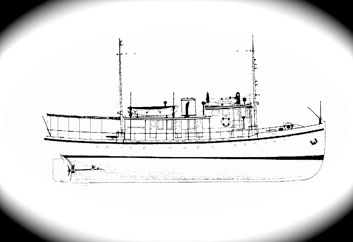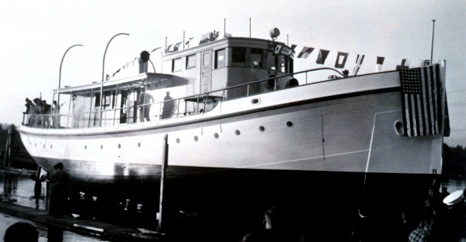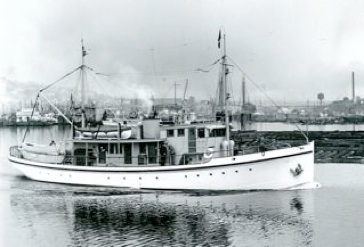The SUMMER WIND was built between 1938 and 1940 by the Astoria Shipyard in Astoria, Oregon for the United States Coast & Geodetic Survey (now part of NOAA). According to the design criteria, she was to be large enough to be self-sufficient at sea for up to 6 months with a crew of 3 officers and 14 sailors and surveyors, yet small and maneuverable enough to enter small uncharted bays. She was commissioned to produce the first modern nautical charts of the Aleutian Islands, which required crossing some of the roughest and most inhospitable ocean in the world. Her design was featured in the 1942 version of the United States Hydrographic Manual
Although built to work, the SUMMER WIND was given the lines of a classic fantail yacht. Her designer,H. C. Hansen, was said to be influenced in his early years by Ted Geary, a famous yacht designer who produced many classic fantail yachts of the 1920’s such as the Thea Foss, the Blue Peter, and the Malibu. Later Hansen designs were decidedly boxier and less graceful-looking.
Astoria Marine Construction used the finest materials and craftsmanship, including old growth fir planks up to 80 feet long, 8X8” oak frames, pressure treated lumber, monel fastenings, ironbark toerails and rubrails, and Burmese teak. After launching and commissioning, she arrived in Seattle in February 1940 and was put into service just before and during World War II surveying the Aleutian Islands in the summer and working in Puget Sound in the winter. She completed a “wire drag” survey of Puget Sound in 1943 that generated data about depth and bottom contours that are still shown on charts today. Her work in the Aleutian Islands during World War II is shrouded in mystery due to the high level of security applied to the Aleutian battles now called the Thousand Mile War.
Throughout her military service, she was known as the E LESTER JONES,
after a well-respected commander of the U.S. Coast & Geodetic Survey in the 1920s. E. Lester Jones was also one of the founders of the American Legion. For many years, a plaque hung in the pilothouse of the SUMMER WIND to commemorate this. Interestingly, a reference to this plaque shows up in Websters online dictionary under the definition of “plaque.”
After the war, the SUMMER WIND/E. LESTER JONES performed survey work in Puget Sound, the San Juans, and throughout Alaska as far north as Bristol Bay. Many of the bays and mountains in Southeast Alaska and the Anchorage area were named after her crew members’ relatives. She is also believed to have performed survey work in Hawaii and the Panama Canal. She was fitted with what was then the most modern electronics, including one of the first electronic depth sounders, and an early LORAN unit. Each winter was spent in Seattle at the NOAA dock on Lake Union with a full-time crew of three performing maintenance and upgrades.
In 1971, the SUMMER WIND was surplused and sold at auction. In typical government fashion, the engines were completely rebuilt just prior to the sale. After a brief trip through Central America to Florida, she was purchased by local Seattleite Dave Updike, who returned her to Seattle and owned her for 20 years until his death. She was then purchased by her current owners, who have used her as a cruising yacht and home on Lake Union and Lake Washington since 1993.
Here are some pictures from the NOAA archives of the SUMMER WIND when she was in service:
At dock with sistership
Underway in black & white
Painted gray
At Bartlett Cove, Glacier Bay
At work surveying
Tied at logging camp dock
Beached at the Nushagak River!
Here are pictures of the SUMMER WIND and crew performing surveying operations:
Surveying party at work on deck
Surveying in the Aleutians
Retrieving damaged buoy
Deploying current meter
Deploying current meter off back deck
Preparing buoy on back deck
Picture of first radio current meter tested on Lester Jones
Sea Lions and the Lester Jones




